Propeller moved to Cold War memorial site at Mount Charleston

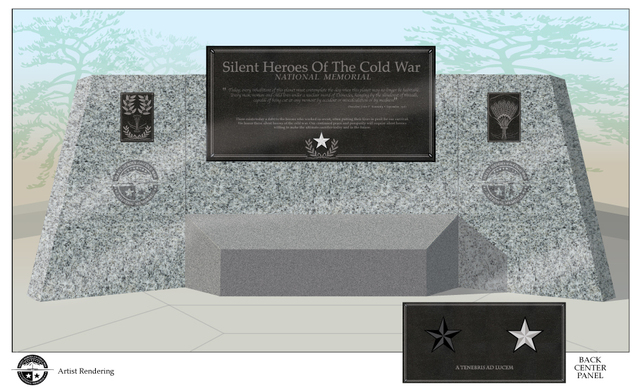
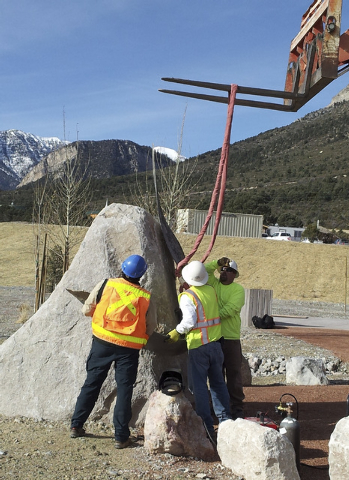
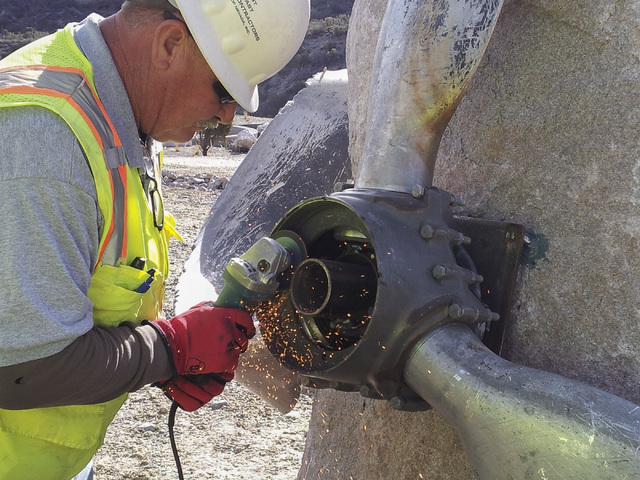
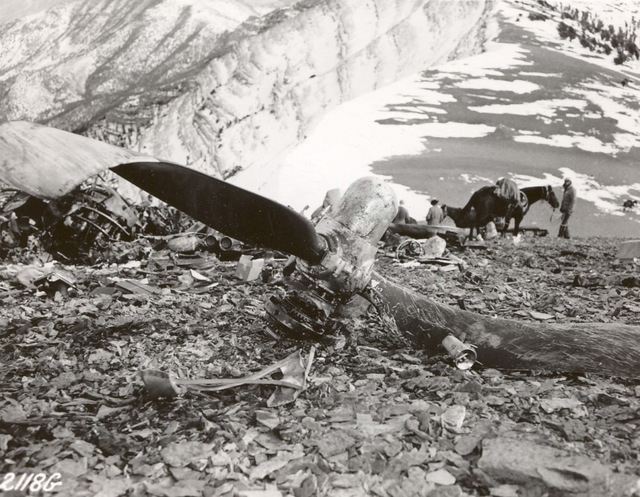

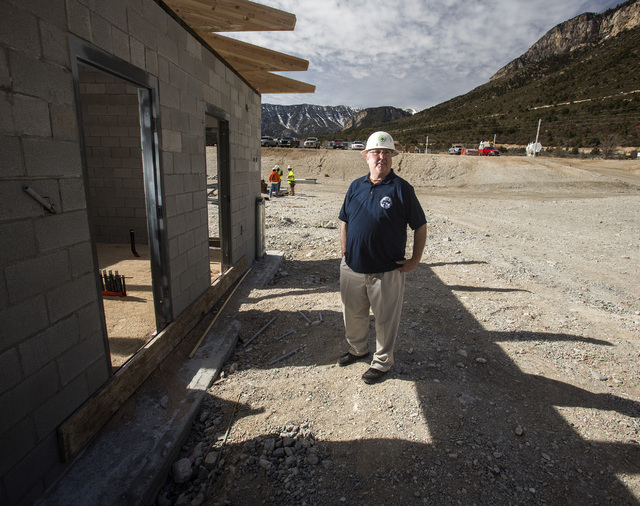
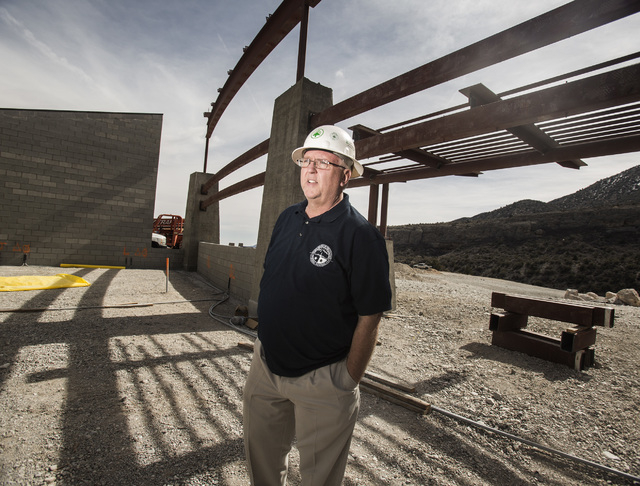


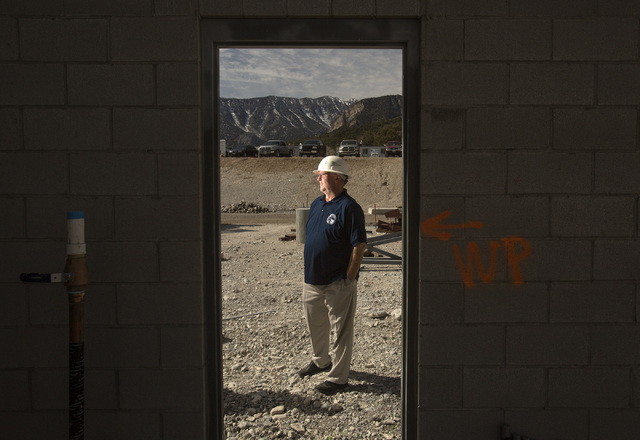
A propeller from a Cold War-era transport plane dangled from a forklift sling as workers prepared to attach it to a boulder.
The scene Monday, 30 miles northwest of Las Vegas, was in view of where the propeller blades were bent as they plowed through a snow-covered ridge atop Charleston Peak when the C-54 transport crashed in 1955 while taking government workers to test the U-2 spy plane at Area 51.
For Steve Ririe, founder and chairman of the Silent Heroes of the Cold War National Memorial Committee, that moment Monday marked a milestone he launched to honor the 14 who died in the crash.
“Every time I see the propeller, it reminds me of when I first saw it, and felt the violence of the crash from seeing how twisted it is,” he said. “Now having known the families, what I see in the propeller is all the pain they endured over the four decades that they didn’t fully understand what happened.”
Ririe solved much of the mystery when he got the government to declassify documents about the crash and the secret mission they were on. Then in August 2001, he hiked to the crash site with family members of some of the men who were killed and, with permission of the U.S. Forest Service, recovered the propeller.
He displayed it at events to raise $200,000 for what is called the “USAF 9068” Memorial, named for the Air Force plane that crashed.
When completed in the spring, that memorial will flank the Silent Heroes of the Cold War National Memorial made of white granite from Vermont and black granite from South Africa.
President John F. Kennedy’s 1961 “nuclear sword” quote will appear on the front. On the back will be a white star to represent Cold War workers who are recognized openly and a black star for those whose contributions to national security haven’t yet been declassified. The memorial’s motto is a Latin phrase, “A Tenebris Ad Lucem,” which means “from darkness to light.”
It’s for those who worked at Area 51, the CIA, the former Nevada Test Site — now the Nevada National Security Site — and elsewhere in the nation’s nuclear weapons complex: “the people who kept the nuclear missiles in the silos and kept the Cold War from going hot,” Ririe said.
The memorials will be attractions at the Spring Mountains Visitor Gateway. The $45 million, 90-acre recreation area project off state Route 157 will serve as an information and transportation hub for the Spring Mountains.
The Gateway project, funded through the sale of public land under the Southern Nevada Public Land Management Act, includes a visitor center, picnic area, hiking, biking and horseback riding trails, and amphitheaters along with firefighting and administration facilities.
Eight pedestrian bridges will span a creek, and a public telescope will be installed for viewing the USAF 9068 crash site.
It was near the 12,000-foot Charleston Peak where the plane crashed. Ririe was inspired to chart a course for the memorials after he hiked there in 1998 and wondered who died in the wreckage.
After following a trail of records from the Air Force to the National Archives and Records Administration to the CIA, he sought and obtained a declassified investigation report that launched his odyssey to find the families of the men who were killed.
Investigators determined that the C-54 transport plane had departed Burbank, Calif., on Nov. 17, 1955, bound for the secret “Watertown” airstrip along Nevada’s dry Groom Lake bed, 90 miles north of the Las Vegas Valley.
After arriving at what is now widely known as Area 51, the team was supposed to perform a flight test of the U-2, a high-flying spy plane equipped with long-range cameras.
The pilot had become disoriented while trying to fly in radio silence through a crosswind under visual flight rules during a blizzard.
Instead of avoiding Charleston Peak, he was mistakenly on a path toward the peak above Kyle Canyon.
The plane clipped the ridge 50 feet below the crest then skipped and slid before it partially burned.
The USAF 9068 memorial is paid for, but Ririe is trying to raise another $10,000 to assist the families in attending a dedication ceremony at the end of May. Donations can be made at the nonprofit group’s website, www.coldwarmonument.org.
Contact Keith Rogers at krogers@reviewjournal.com or 702-383-0308. Find him on Twitter: @KeithRogers2.
Victims in 1955 plane crash on Mount Charleston
The following is a list of the 14 men who died when their C-54 transport plane crashed on Mount Charleston on Nov. 17, 1955:
• William H. Marr, 37, of Hyattsville, Md., chief CIA security officer for the U-2 project. He was awarded the CIA’s Intelligence Medal of Merit posthumously.
• James F. Bray, 48, of Houston, the CIA’s regional deputy chief security stationed at the Groom Lake installation.
• James W. “Billy” Brown, 23, of Savannah, Ga., a CIA security staff member.
• Staff Sgt. Clayton D. Farris, 26, of Walnut, Iowa, a flight mechanic technician.
• Airman 2nd Class Guy R. Fasolas, 22, a flight attendant from Nephi, Utah.
• Sgt. John H. Gaines, 23, of Ripley, Tenn., an Air Force flight navigator.
• Richard J. Hruda, 37, a Lockheed engineer, from Burbank, Calif.
• Edwin J. Urolatis, 27, a CIA security officer, from Brockton, Mass.
• Rodney Kreimendahl, 38, a Lockheed engineer, from San Fernando Valley, Calif.
• 1st Lt. George M. Pappas Jr., 27, Air Force pilot, from Amarillo, Texas. He was promoted to captain posthumously.
• 2nd Lt. Paul E. Winham, 24, Air Force co-pilot, from San Antonio.
• Fred F. Hanks, 35, Hycon camera repair specialist, of Sierra Madre, Calif.
• Harold C. Silent, 59, Hycon consultant and physicist, of Glendora, Calif.
• Terence J. O’Donnell, 22, CIA security officer, from Parkchester in the Bronx, N.Y.












